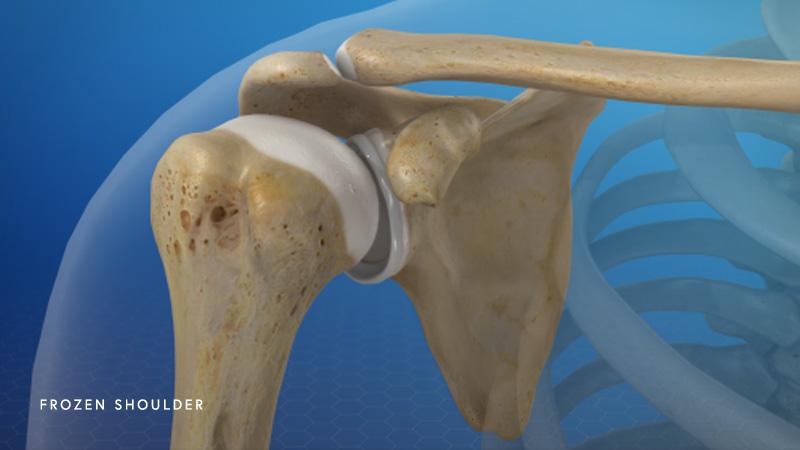Frozen Shoulder
The shoulder is one of the largest and most complex joints in the body. A ball-and-socket joint, it is comprised of the humerus (upper arm bone), the scapula (shoulder blade) and the clavicle (collarbone). The humerus bone fits into the scapula socket, and is surrounded by the shoulder capsule, which is made up of strong connective tissue. Fluid called synovium lubricates the joint and shoulder capsule to allow for smooth range of motion.
Frozen shoulder, or adhesive capsulitis, is a common condition that causes stiffness and pain in the shoulder joint, ultimately making it difficult to move, or “frozen.” In frozen shoulder, the shoulder capsule thickens, becoming tight and stiff, restricting movement of the shoulder. Bands of tissue called adhesions develop, and in many cases, there is a decrease of lubricating fluid in the joint.
Frozen shoulder often develops slowly with pain and stiffness, but progresses to a loss of normal range of motion in the shoulder. The condition tends to get better on its own, though doctors can help manage the pain and recommend treatments and therapy that can help speed recovery.

Doctors aren’t certain exactly what causes the shoulder capsule to thicken and stiffen in frozen shoulder, although immobility of the shoulder from a surgery or injury is often a contributing factor.
Diabetes is also known to increase a patient’s risk factor for the condition. In addition, those with diseases including hypothyroidism, hyperthyroidism, Parkinson’s disease and cardiovascular disease have a higher incidence of frozen shoulder. Women over the age of 40 are more susceptible to frozen shoulder.
Frozen shoulder causes pain and stiffness in the shoulder area. Patients often find it increasingly difficult to move the shoulder. Pain has been known to increase at night due to immobility. There are three basic stages of frozen shoulder:
Freezing Stage
During the freezing stage, movement of the shoulder becomes increasingly painful. The shoulder’s range of motion will also become limited. This stage can last from 6 weeks to 9 months.
Frozen Stage
In the frozen stage, pain may begin to diminish or transform from a sharp pain to a dull pain. The shoulder becomes stiffer and range of motion significantly decreases, which can make everyday activities challenging. This state often lasts approximately 4 to 6 months.
Thawing Stage
In the thawing stage, range of motion begins to improve and pain lessens. Normal motion may return to the shoulder typically between from 6 months to 2 years.
To diagnose frozen shoulder, your doctor will discuss your medical history, in addition to performing a physical exam. Your doctor may check your active range of motion, by asking you to move in certain ways as he or she checks for pain or stiffness. You will also be asked to relax your muscles as your doctor moves your arm to check for passive range of motion.
Sometimes, your doctor might recommend injecting a numbing medicine into your shoulder to better determine passive and active range of motion, which are both affected by frozen shoulder.
Typically, frozen shoulder can be confirmed with signs and symptoms. But in some cases, a doctor will suggest an x-ray and/or MRI to rule out other potential conditions.
Frozen shoulder usually resolves itself after a period of time, so the goal of treatment usually focuses on minimizing pain and preserving as much range of motion as possible during the three stages of frozen shoulder. Doctors may recommend NSAIDs to help reduce pain and inflammation in the shoulder. In addition, physical therapy and range-of-motion exercises can help a patient maintain and recover shoulder mobility.
Surgical and other procedures
Most frozen shoulders heal on their own in a year or two. However, for persistent symptoms, your doctor may suggest:
- Steroid injections – A doctor can inject corticosteroids into the shoulder joint to help decrease pain and improve mobility.
- Joint distension – Sterile water can be injected into the joint capsule of the shoulder to help stretch the tissue and promote ease of movement in the joint
- Shoulder manipulation – In this procedure, a patient will undergo general anesthesia. The doctor will then move the shoulder joint in different directions to loosen the tightened tissue
- Surgery – Surgery for frozen shoulder is rare, but if all other treatment options are exhausted, surgery to remove scar tissue and adhesions from inside your shoulder joint may be recommended by your doctor. This surgery is usually done arthroscopically (through small incisions around the joint).
Finding treatment options for frozen shoulder
The Center for Orthopaedic Specialists of California has been providing individuals with the care and treatment they need to get moving again for many years. If you or a loved one are currently experiencing any of the symptoms of frozen shoulder or would simply like more information, contact the Center for Orthopaedic Specialists today!




 / 50 Reviews
/ 50 Reviews